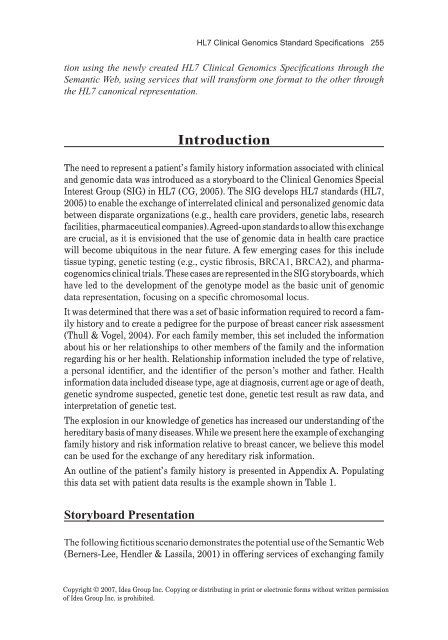Semantic Web-Based Information Systems: State-of-the-Art ...
Semantic Web-Based Information Systems: State-of-the-Art ...
Semantic Web-Based Information Systems: State-of-the-Art ...
You also want an ePaper? Increase the reach of your titles
YUMPU automatically turns print PDFs into web optimized ePapers that Google loves.
HL7 Clinical Genomics Standard Specifications 255<br />
tion using <strong>the</strong> newly created HL7 Clinical Genomics Specifications through <strong>the</strong><br />
<strong>Semantic</strong> <strong>Web</strong>, using services that will transform one format to <strong>the</strong> o<strong>the</strong>r through<br />
<strong>the</strong> HL7 canonical representation.<br />
Introduction<br />
The need to represent a patient’s family history information associated with clinical<br />
and genomic data was introduced as a storyboard to <strong>the</strong> Clinical Genomics Special<br />
Interest Group (SIG) in HL7 (CG, 2005). The SIG develops HL7 standards (HL7,<br />
2005) to enable <strong>the</strong> exchange <strong>of</strong> interrelated clinical and personalized genomic data<br />
between disparate organizations (e.g., health care providers, genetic labs, research<br />
facilities, pharmaceutical companies). Agreed-upon standards to allow this exchange<br />
are crucial, as it is envisioned that <strong>the</strong> use <strong>of</strong> genomic data in health care practice<br />
will become ubiquitous in <strong>the</strong> near future. A few emerging cases for this include<br />
tissue typing, genetic testing (e.g., cystic fibrosis, BRCA1, BRCA2), and pharmacogenomics<br />
clinical trials. These cases are represented in <strong>the</strong> SIG storyboards, which<br />
have led to <strong>the</strong> development <strong>of</strong> <strong>the</strong> genotype model as <strong>the</strong> basic unit <strong>of</strong> genomic<br />
data representation, focusing on a specific chromosomal locus.<br />
It was determined that <strong>the</strong>re was a set <strong>of</strong> basic information required to record a family<br />
history and to create a pedigree for <strong>the</strong> purpose <strong>of</strong> breast cancer risk assessment<br />
(Thull & Vogel, 2004). For each family member, this set included <strong>the</strong> information<br />
about his or her relationships to o<strong>the</strong>r members <strong>of</strong> <strong>the</strong> family and <strong>the</strong> information<br />
regarding his or her health. Relationship information included <strong>the</strong> type <strong>of</strong> relative,<br />
a personal identifier, and <strong>the</strong> identifier <strong>of</strong> <strong>the</strong> person’s mo<strong>the</strong>r and fa<strong>the</strong>r. Health<br />
information data included disease type, age at diagnosis, current age or age <strong>of</strong> death,<br />
genetic syndrome suspected, genetic test done, genetic test result as raw data, and<br />
interpretation <strong>of</strong> genetic test.<br />
The explosion in our knowledge <strong>of</strong> genetics has increased our understanding <strong>of</strong> <strong>the</strong><br />
hereditary basis <strong>of</strong> many diseases. While we present here <strong>the</strong> example <strong>of</strong> exchanging<br />
family history and risk information relative to breast cancer, we believe this model<br />
can be used for <strong>the</strong> exchange <strong>of</strong> any hereditary risk information.<br />
An outline <strong>of</strong> <strong>the</strong> patient’s family history is presented in Appendix A. Populating<br />
this data set with patient data results is <strong>the</strong> example shown in Table 1.<br />
Storyboard.Presentation<br />
The following fictitious scenario demonstrates <strong>the</strong> potential use <strong>of</strong> <strong>the</strong> <strong>Semantic</strong> <strong>Web</strong><br />
(Berners-Lee, Hendler & Lassila, 2001) in <strong>of</strong>fering services <strong>of</strong> exchanging family<br />
Copyright © 2007, Idea Group Inc. Copying or distributing in print or electronic forms without written permission<br />
<strong>of</strong> Idea Group Inc. is prohibited.


